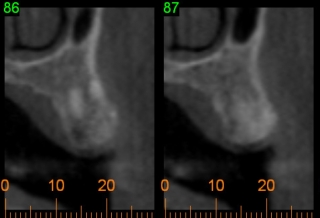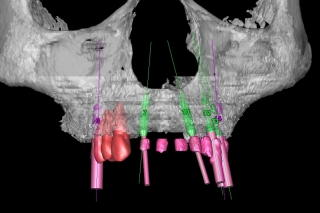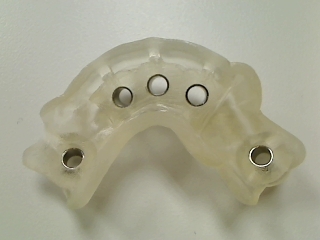We use several current technologies that allows proper planning and dental implant placement for teeth that look great and can last a lifetime. CT scan and computer planning helps the implant surgeon and your restorative dentist place and restore the dental implants with high precision and accuracy. This translates into a better outcome, improved cosmetic results, and potentially lifetime longevity of the implants.
What is CT-Scan Guided Planning?
Proper planning and positioning of the dental implants with precision is vital to achieving highly cosmetic, functional, and long-lasting results. With our cone beam CT-scan along with 3-dimensional treatment planning, we can place the implants in the exact position required to support the overlying crown or other prosthesis. It also provides exact dimensions of the bone and surrounding structures such as nerves and sinuses, so that implant placement can be done with accuracy and safely.
Three stages of CT-Guided implant planning:
1. Diagnostic CT scan
First, a special splint with radiographic markers is made before taking the CT scan. This splint is placed in the patient’s mouth while the CT scan is being obtained to demonstrate the required position of the implant and aid the surgeon in treatment planning. The CT scan images with the markers already captured, will demonstrate precise position of the implants, exact size of the bone, as well as location and proximity of vital structures such as nerves and sinuses.
A CT scan may also be done without the radiographic marker. In this case it can be used to measure existing bone and evaluate other structures in proximity. The radiographic marker (also known as CT prosthesis) provides additional references for the surgeon and the restorative dentist when planning the treatment.
2. Three-dimensional treatment planning
Next the CT data is reconstructed into a 3-dimensional computer model. With a special software, the surgeon can now position the implants in the desired locations- all virtually. The correct width and length of the implants are selected to assure safe placement with respect to surrounding nerves and sinuses. This 3-dimensional model can be easily shared with the restorative dentist to make sure they are positioned with precision for the support of future prosthesis.
3. Surgical guide
The computer dental implant work-up is then used to fabricate plastic surgical guides which will allow the surgeon to place the implants according to the 3-dimensional virtual work-up. The surgical guides are made to fit patient’s mouth with precision, therefore allowing the surgeon to position the implants exactly as planned.
When is CT-guided planning recommended?
We recommend CT-guided implant planning in patients with full mouth implant restorations, those with highly aesthetic challenges, or patients with bone loss. CT-guided planning is not required in every patient as conventional planning and implant placement can be done with great accuracy and outcomes in many situations. Because of added cost, we recommend this type of technology and planning only when it offers great benefits to the patient and the ultimate outcome of the treatment.


